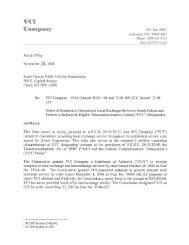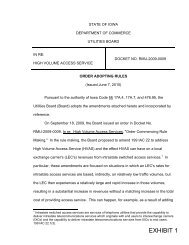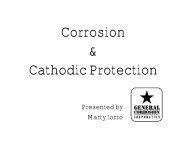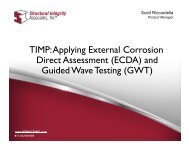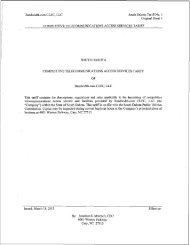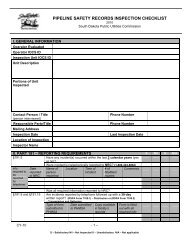Pipeline Safety Inspection Form
Pipeline Safety Inspection Form
Pipeline Safety Inspection Form
Create successful ePaper yourself
Turn your PDF publications into a flip-book with our unique Google optimized e-Paper software.
EXTERNAL CORROSION CONTROL S N/I U N/A<br />
(3) existing bare or coated distribution lines?<br />
§192.459 When the operator has knowledge that any pipeline is exposed, is<br />
the exposed pipe examined for:<br />
(a) Evidence of corrosion?<br />
(b) Coating deterioration?<br />
§192.459 If external corrosion requiring remedial action is found, is the<br />
pipeline investigated circumferentially and longitudinally beyond the<br />
exposed portion to determine whether additional corrosion<br />
requiring remedial action exists?<br />
§192.459 Does operator have procedures established for examining exposed<br />
cast iron pipe for evidence of graphitization?<br />
Does operator have procedures established for remedial measures<br />
on cast iron pipe if graphitization is discovered, AGA GPTC<br />
Appendix G-18 (NTSB)?<br />
§192.461(a) Does the coating on steel pipe meet the requirements of this part?<br />
(1) applied on a properly prepared surface?<br />
(2) has sufficient adhesion to resist underfilm migration of<br />
moisture?<br />
(3) sufficiently ductile to resist cracking?<br />
(4) has sufficient strength to resist damage due to handling and soil<br />
stress?<br />
(5) compatible with supplemental cathodic protection?<br />
§192.461(b) If external coating is electrically insulating does it have low moisture<br />
absorption and high electrical resistance?<br />
§192.461(c) Is the external coating inspected prior to lowering the pipe into the<br />
ditch and is any damage repaired?<br />
§192.461(d) Is external protective coating protected from damage resulting from<br />
adverse ditch conditions or damage from supporting blocks?<br />
§192.461(e) If coated pipe is installed by boring, driving, or similar method, are<br />
precautions taken to minimize damage to the coating?<br />
§192.463 (a) Does the level of cathodic protection meet the requirements of<br />
Appendix D criteria?<br />
Appendix D Steel, cast iron, and ductile iron<br />
Part I (1) a negative (cathodic) voltage of at least 0.85 volt (Cu-CuSO4 ½<br />
cell) also need to consider IR drop<br />
(2) a negative voltage shift of at least 300 millivolts (applies to<br />
structure not in contact with metals of different anodic potentials)<br />
also need to consider IR drop<br />
(3) a minimum negative polarization voltage shift of 100 millivolts<br />
(interrupting the protective current and measuring the polarization<br />
decay)<br />
(4) voltage at least as negative as that originally established at<br />
beginning of Tafel segment of E-log-I curve<br />
(5) net protective current<br />
Refer to Appendix D if aluminum, copper, or other metals are within<br />
the system also note that other reference cells besides Cu-CuSO4<br />
half-cells can be used if they meet criteria in Section IV of Appendix<br />
§192<br />
Appendix D.<br />
Part II<br />
D<br />
Does the operator criteria consider IR drop?<br />
§192.463 (b) If amphoteric metals are included in a buried or submerged pipeline<br />
containing a metal or different anodic potential are they:<br />
S – Satisfactory N/I – Not Inspected U – Unsatisfactory N/A – Not applicable<br />
- 2 -



